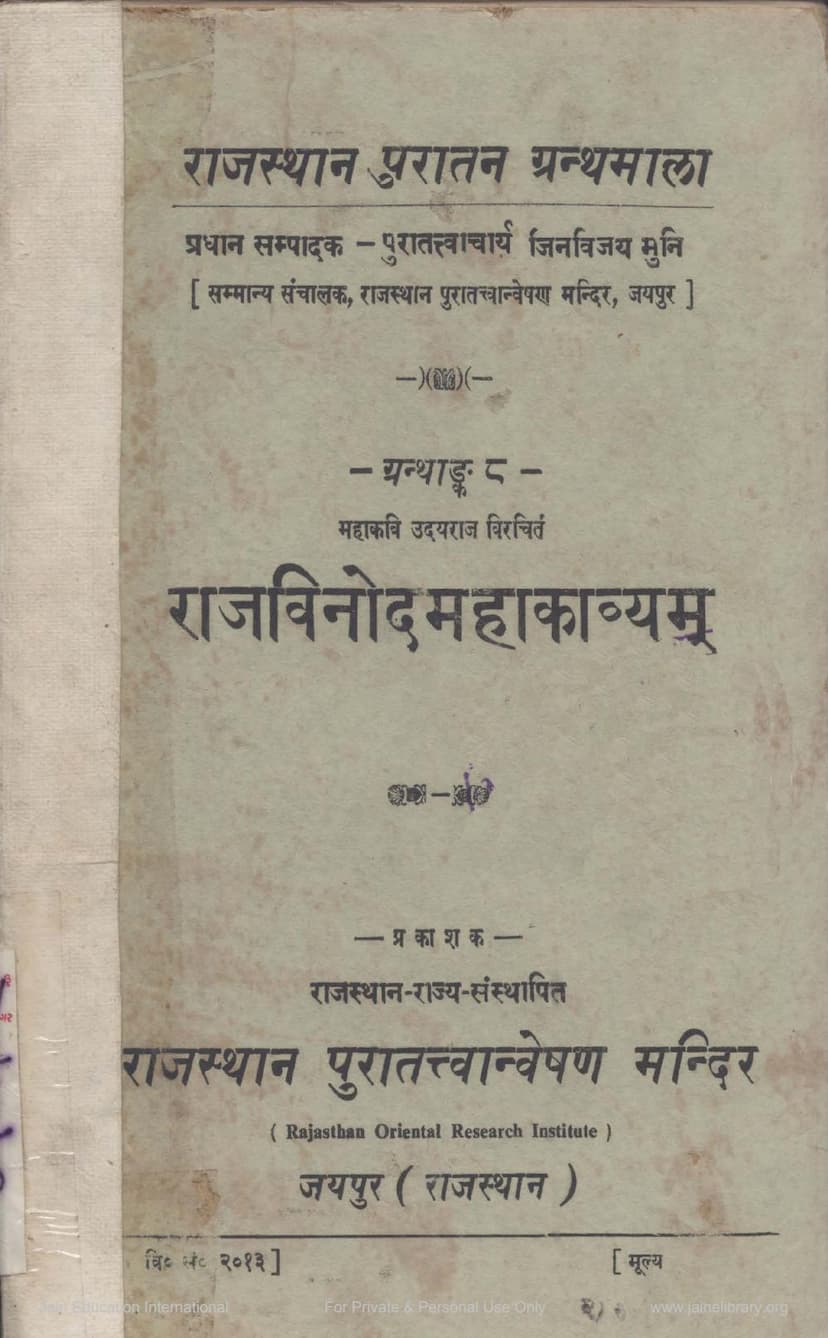Rajvinod Mahakavyam
Added to library: September 2, 2025

Summary
The document provided is a catalog excerpt for a book titled Rajvinod Mahakavyam, written by Udayraj Mahakavi and edited by Gopalnarayan Bahura, published by Rajasthan Oriental Research Institute (Rajasthan Puratattvanveshan Mandir) in Jaipur in Vikram Samvat 2013 (1956 CE).
Here's a comprehensive summary in English based on the provided pages:
Book Title: Rajvinod Mahakavyam Author: Udayraj Mahakavi Editor: Gopalnarayan Bahura Publisher: Rajasthan Oriental Research Institute (Rajasthan Puratattvanveshan Mandir), Jaipur Series: Rajasthan Puratan Granthamala, Volume 8
Summary of Content:
The Rajvinod Mahakavyam is a Sanskrit epic poem composed by Udayraj Mahakavi, a court poet of Sultan Mahmud Begada of Ahmedabad. The work is essentially a eulogy of Sultan Mahmud Begada, a powerful, heroic, and dutiful ruler of Gujarat.
Key Highlights and Information:
- Historical Significance: The poem sheds light on new facts concerning medieval Indian history, particularly the contemporary situation in Rajasthan and broader historical events of Mahmud Begada's reign.
- Discovery and Publication: The importance of the "Rajvinod" was first recognized by Dr. Bühler in 1875 CE, who obtained a manuscript for the Bombay government. The need for its publication was recognized since then. The Rajasthan Oriental Research Institute, upon its establishment, acquired a copy from the Bhandarkar Oriental Research Institute in Pune to facilitate its publication.
- Editor's Contribution: Mr. Gopalnarayan Bahura, the editor, has enriched the book with an introductory essay, genealogical information about Mahmud Begada based on historical texts, a translation of the Dohad inscription by Dr. H.D. Sankalia, and an index, thus enhancing its utility.
- Structure of the Poem: The epic is divided into seven Sargas (Cantos):
- Surendra-Saraswati-Samvad (Dialogue of Indra and Saraswati): This introductory canto describes Brahma sending Indra to find Saraswati, whom he finds in Mahmud's assembly hall. Saraswati then explains her presence by praising Mahmud.
- Vamshanukirtan (Genealogy): This canto details the lineage of Sultan Mahmud. The presented genealogy is noted to be historically accurate.
- Sabha Samagam (Assembly Gathering): This describes Mahmud's entry into the court and the types of kings and dignitaries present.
- Sarvasara (All Occasions/Kings): This canto lists and describes the various kings and rulers who attended Mahmud's court and were subservient to him. It also mentions specific rulers like the Malwa king and Rana Kumbha of Mewar.
- Sangeetrangprasang (Musical Entertainment): This canto focuses on the musical and artistic performances in the Sultan's court.
- Vijayayatrotsav Varnan (Description of Victory Procession): This describes the celebrations and processions related to Mahmud's military victories.
- Vijayalakshmilabh (Attainment of Victory Goddess): This canto details Mahmud's military prowess and battlefield achievements.
- Udayraj's Perspective: Udayraj, a Hindu Sanskrit poet, was a dependent of Mahmud Begada. He describes Mahmud as a powerful and protective ruler, akin to a Hindu king, calling him the "crest-jewel of kings" (Rajanyachudamani). He states that both Lakshmi (wealth) and Saraswati (knowledge/arts) serve him. He also exaggerates Mahmud's generosity, comparing him to Karna.
- Historical Context and Dating: The poem was likely composed during Mahmud Begada's reign (1458-1511 CE), likely between 1463 and 1466 CE, as it mentions Rana Kumbha of Mewar (ruled 1433-1468 CE) being subservient to Mahmud.
- Comparison with Dohad Inscription: The document includes a detailed comparison between the "Rajvinod" and a Dohad inscription (dated 1488 CE), highlighting similarities in language, style, and genealogical details. It suggests the possibility that Udayraj might also be the author of the inscription. The inscription confirms Mahmud's lineage and some of his military achievements.
- Mahmud Begada's Dynasty and Reign: A significant portion of the document is dedicated to a detailed "Vamsh Parichay" (Genealogy of Mahmud Begada), tracing his lineage from Rajput ancestry. It recounts the conversion of his ancestors to Islam and their rise to power in Gujarat. It also provides a chronological account of Mahmud Begada's reign (1458-1511 CE), detailing his military campaigns, administrative actions, architectural projects (like founding Ahmedabad and Mehmadabad), and personal characteristics. His epithet "Begada" is explained through two theories: one related to his long, spread-out horns (a physical description) and the other to his conquest of two significant forts (Junagadh and Champaner).
- Udayraj's Role and Motivation: The poem highlights Udayraj's talent and his attempt to gain royal patronage through his poetic skills. The text suggests that while Mahmud was a devout Muslim, he patronized Hindu scholars like Udayraj, possibly finding satisfaction in the Sanskrit praise.
- Manuscript Information: The sole ancient handwritten copy of the "Rajvinod" is preserved in the Bhandarkar Oriental Research Institute, Pune. The manuscript has 28 pages and is in a good state of preservation, suggesting it was written relatively close to the original composition. It was written by a scribe named Ram for his son's reading.
- Appreciation of Udayraj: The author of the preface acknowledges Udayraj for his contribution to Sanskrit poetry and for bringing historical events and aspects of Mahmud's character to light through his work.
In essence, the Rajvinod Mahakavyam is a valuable historical and literary work that offers insights into the life and achievements of Sultan Mahmud Begada, presented through the skillful Sanskrit verses of his court poet, Udayraj. The publication by the Rajasthan Oriental Research Institute makes this rare work accessible to scholars and history enthusiasts.